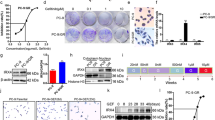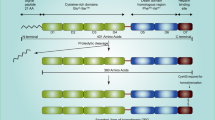Abstract
1α,25-Dihydroxyvitamin D3 (1α,25(OH)2D3) has antitumor activity in addition to its classical action on calcium metabolism and bone tissue biology. It is thought to regulate the expression of multiple target genes and thus modulate processes critical for tumor growth and metastases. Here we show that 1α,25(OH)2D3 differentially regulates the expression of Id1 and Id2 genes, members of a family of transcriptional regulators of cell proliferation and differentiation. 1α,25(OH)2D3 induced epithelial differentiation in SW480-ADH human colon carcinoma cell line by promoting expression of the proteins implicated in adherent junction formation, including E-cadherin, and by inhibiting β-catenin transcriptional activity. 1α,25(OH)2D3 activated the human Id1 gene promoter and rapidly induced Id1 RNA and protein. Ectopic overexpression of Id1 was not sufficient to induce E-cadherin, which was critical for the morphological changes induced by 1α,25(OH)2D3 in SW480-ADH cells. Conversely, Id2 transcription rate, RNA and protein levels were decreased by 1α,25(OH)2D3. Id2 downregulation by 1α,25(OH)2D3 mediated the antiproliferative effect of 1α,25(OH)2D3 on SW480-ADH cells. In addition, we showed that 1α,25(OH)2D3 changed the levels of the inducer of angiogenesis, vascular endothelial growth factor and the potent antiangiogenic factor thrombospondin-1, leading to a balanced change in the angiogenic potential of SW480-ADH human colon carcinoma cells.
This is a preview of subscription content, access via your institution
Access options
Subscribe to this journal
Receive 50 print issues and online access
$259.00 per year
only $5.18 per issue
Buy this article
- Purchase on Springer Link
- Instant access to full article PDF
Prices may be subject to local taxes which are calculated during checkout








Similar content being viewed by others
References
Behrens J . (2000). Ann. N.Y. Acad. Sci., 910, 21–33; discussion 33–35.
Benezra R, Rafii S and Lyden D . (2001). Oncogene, 20, 8334–8341.
Bernardi RJ, Johnson CS, Modzelewski RA and Trump DL . (2002). Endocrinology, 143, 2508–2514.
Chomczynski P and Sacchi N . (1987). Anal. Biochem., 162, 156–159.
Church GM and Gilbert W . (1984). Proc. Natl. Acad. Sci. USA, 81, 1991–1995.
Dalhoff K, Dancey J, Astrup L, Skovsgaard T, Hamberg KJ, Lofts FJ, Rosmorduc O, Erlinger S, Bach Hansen J, Steward WP, Skov T, Burcharth F and Evans TR . (2003). Br. J. Cancer, 89, 252–257.
Dameron KM, Volpert OV, Tainsky MA and Bouck N . (1994). Science, 265, 1582–1584.
Diaz GD, Paraskeva C, Thomas MG, Binderup L and Hague A . (2000). Cancer Res., 60, 2304–2312.
Evans SR, Shchepotin EI, Young H, Rochon J, Uskokovic M and Shchepotin IB . (2000). Int. J. Oncol., 16, 1249–1254.
Ezura Y, Tournay O, Nifuji A and Noda M . (1997). J. Biol. Chem., 272, 29865–29872.
Gross C, Stamey T, Hancock S and Feldman D . (1998). J. Urol., 159, 2035–2039; discussion 2039–2040.
Gulliford T, English J, Colston KW, Menday P, Moller S and Coombes RC . (1998). Br. J. Cancer, 78, 6–13.
Gumireddy K, Ikegaki N, Phillips PC, Sutton LN and Reddy CD . (2003). Biochem. Pharmacol., 65, 1943–1955.
Guyton KZ, Kensler TW and Posner GH . (2001). Annu. Rev. Pharmacol. Toxicol., 41, 421–442.
Halline AG, Davidson NO, Skarosi SF, Sitrin MD, Tietze C, Alpers DH and Brasitus TA . (1994). Endocrinology, 134, 1710–1717.
Hewitt RE, McMarlin A, Kleiner D, Wersto R, Martin P, Tsokos M, Stamp GW, Stetler-Stevenson WG and Tsoskas M . (2000). J. Pathol., 192, 446–454.
Iseki K, Tatsuta M, Uehara H, Iishi H, Yano H, Sakai N and Ishiguro S . (1999). Int. J. Cancer, 81, 730–733.
Israel MA, Hernandez MC, Florio M, Andres-Barquin PJ, Mantani A, Carter JH and Julin CM . (1999). Cancer Res., 59, 1726s–1730s.
Jensen SS, Madsen MW, Lukas J, Binderup L and Bartek J . (2001). Mol. Endocrinol., 15, 1370–1380.
Koli K and Keski-Oja J . (2000). Cell Growth Differ., 11, 221–229.
Lasorella A, Boldrini R, Dominici C, Donfrancesco A, Yokota Y, Inserra A and Iavarone A . (2002). Cancer Res., 62, 301–306.
Lasorella A, Iavarone A and Israel MA . (1996). Mol. Cell. Biol., 16, 2570–2578.
Lasorella A, Noseda M, Beyna M, Yokota Y and Iavarone A . (2000). Nature, 407, 592–598.
Lasorella A, Uo T and Iavarone A . (2001). Oncogene, 20, 8326–8333.
Leibovitz A, Stinson JC, McCombs III WB, McCoy CE, Mazur KC and Mabry ND . (1976). Cancer Res., 36, 4562–4569.
Liu Y, Encinas M, Comella JX, Aldea M and Gallego C . (2004). Mol. Cell. Biol., 24, 2662–2672.
Lyden D, Young AZ, Zagzag D, Yan W, Gerald W, O'Reilly R, Bader BL, Hynes RO, Zhuang Y, Manova K and Benezra R . (1999). Nature, 401, 670–677.
Mantell DJ, Owens PE, Bundred NJ, Mawer EB and Canfield AE . (2000). Circ. Res., 87, 214–220.
Matsumura ME, Lobe DR and McNamara CA . (2002). J. Biol. Chem., 277, 7293–7297.
Nehlin JO, Hara E, Kuo WL, Collins C and Campisi J . (1997). Biochem. Biophys. Res. Commun., 231, 628–634.
Nishii Y and Okano T . (2001). Steroids, 66, 137–146.
Palmer HG, Gonzalez-Sancho JM, Espada J, Berciano MT, Puig I, Baulida J, Quintanilla M, Cano A, de Herreros AG, Lafarga M and Munoz A . (2001). J. Cell Biol., 154, 369–387.
Palmer HG, Sanchez-Carbayo M, Ordonez-Moran P, Larriba MJ, Cordon-Cardo C and Munoz A . (2003). Cancer Res., 63, 7799–7806.
Ramsauer M and D'Amore PA . (2002). J. Clin. Invest., 110, 1615–1617.
Rockman SP, Currie SA, Ciavarella M, Vincan E, Dow C, Thomas RJ and Phillips WA . (2001). J. Biol. Chem., 276, 45113–45119.
Ruzinova MB, Schoer RA, Gerald W, Egan JE, Pandolfi PP, Rafii S, Manova K, Mittal V and Benezra R . (2003). Cancer Cell, 4, 277–289.
Scaglione-Sewell BA, Bissonnette M, Skarosi S, Abraham C and Brasitus TA . (2000). Endocrinology, 141, 3931–3939.
Schlaeppi JM, Gutzwiller S, Finkenzeller G and Fournier B . (1997). Endocr. Res., 23, 213–229.
Sikder HA, Devlin MK, Dunlap S, Ryu B and Alani RM . (2003). Cancer Cell, 3, 525–530.
Smith DC, Johnson CS, Freeman CC, Muindi J, Wilson JW and Trump DL . (1999). Clin. Cancer Res., 5, 1339–1345.
Vennstrom B and Bishop JM . (1982). Cell, 28, 135–143.
Verlinden L, Verstuyf A, Convents R, Marcelis S, Van Camp M and Bouillon R . (1998). Mol. Cell. Endocrinol., 142, 57–65.
Volpert OV, Pili R, Sikder HA, Nelius T, Zaichuk T, Morris C, Shiflett CB, Devlin MK, Conant K and Alani RM . (2002). Cancer Cell, 2, 473–483.
Wilson JW, Deed RW, Inoue T, Balzi M, Becciolini A, Faraoni P, Potten CS and Norton JD . (2001). Cancer Res., 61, 8803–8810.
Woo PL, Cercek A, Desprez PY and Firestone GL . (2000). J. Biol. Chem., 275, 28649–28658.
Yam CH, Fung TK and Poon RY . (2002). Cell Mol. Life Sci., 59, 1317–1326.
Yokota Y . (2001). Oncogene, 20, 8290–8298.
Zebedee Z and Hara E . (2001). Oncogene, 20, 8317–8325.
Acknowledgements
We acknowledge with gratitude all researchers who contributed the reagents: J Campisi for Id1 promoter, E Hara for pGEXId1A, JD Norton for pcDNA3-Id2, AG Herreros for E-cadherin promoter constructs, A Alfranca for VEGF promoter and A Bernad for pLZR-iresEGFP, I Palmero for anti-p21 antibody, C Cales for anti-cyclin A antibody. We specially acknowledge C Cales, M Campanero and I Palmero for their advice in cell cycle. This work was supported by grants SAF-2001-1349 and SAF-2004-04152 from Ministerio de Ciencia y Tecnología to B Jimenez, SAF2004-01015 to A Munoz and SAF-2004-07717 to M del Rio. NI Fernandez and M Garcia has been supported by a Comunidad Autonoma de Madrid fellowship.
Author information
Authors and Affiliations
Corresponding author
Rights and permissions
About this article
Cite this article
Fernandez-Garcia, N., Palmer, H., Garcia, M. et al. 1α,25-Dihydroxyvitamin D3 regulates the expression of Id1 and Id2 genes and the angiogenic phenotype of human colon carcinoma cells. Oncogene 24, 6533–6544 (2005). https://doi.org/10.1038/sj.onc.1208801
Received:
Revised:
Accepted:
Published:
Issue Date:
DOI: https://doi.org/10.1038/sj.onc.1208801
Keywords
This article is cited by
-
Vitamin D Levels in Patients with Colorectal Cancer Before and After Treatment Initiation
Journal of Gastrointestinal Cancer (2019)
-
Influence of genetic variation in the vitamin D pathway on plasma 25-hydroxyvitamin D3 levels and survival among patients with metastatic colorectal cancer
Cancer Causes & Control (2019)
-
New insights into vitamin D anticancer properties: focus on miRNA modulation
Molecular Genetics and Genomics (2017)
-
Vitamin D in cancer: effects of pharmaceutical drugs on the vitamin D pharmacokinetics
Journal of Pharmaceutical Investigation (2014)
-
Vitamin D for Prevention and Treatment of Colorectal Cancer: What is the Evidence?
Current Colorectal Cancer Reports (2014)



